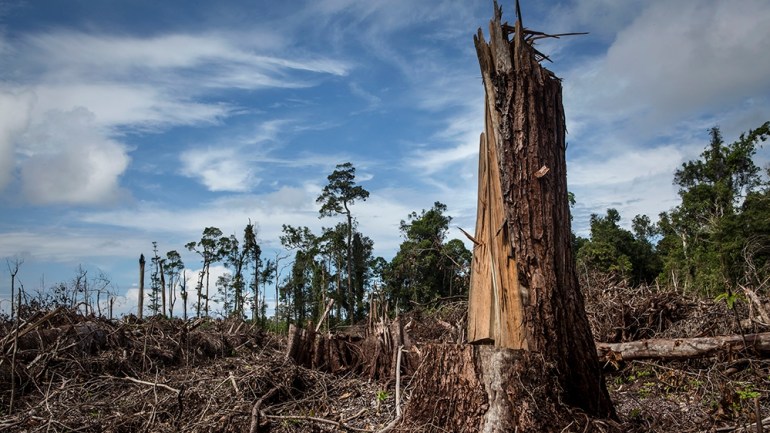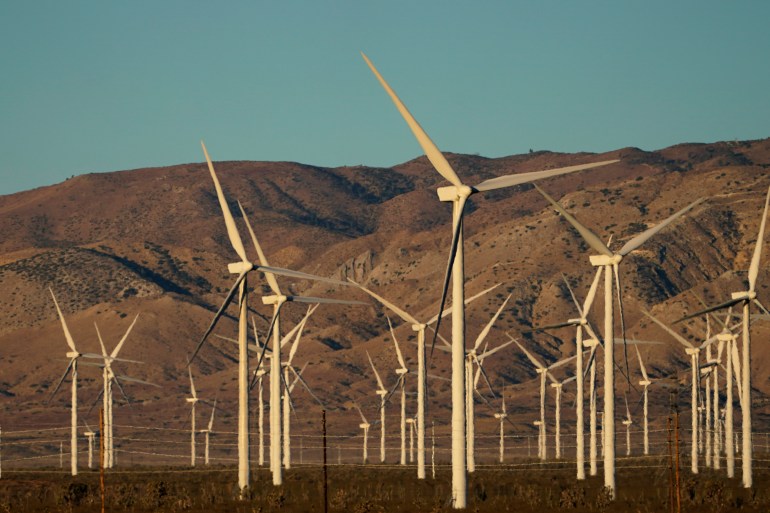How COVID has shone a light on the way we measure economies
A year after COVID-19 became a pandemic, the drumbeat of studies saying we need to overhaul how economies are measured is getting louder.

Vaccines are being rolled out; in some places, people are eating in restaurants again; even some cinemas are opening up. A year after the World Health Organization declared COVID-19 to be a pandemic, the world is slowly returning to a semblance of what it was before the coronavirus began its devastating march.
And with trillions of dollars of stimulus measures acting like a financial shot in the arm of the global economy, stock markets have surged as forecasters such as the Organisation for Economic Co-operation and Development ramp up their projections for economic growth.
Keep reading
list of 4 items‘Playing politics’: World is missing chance to go green-UN report
Investors turn up heat on HSBC to phase out fossil fuel funding
Could coronavirus save the planet by changing economics forever?
But some economists fear that the underlying causes of the pandemic – among them our pursuit of never-ending economic growth at the expense of the world’s limited natural resources – have yet to be addressed.
As the pandemic got under way in 2020, I wrote about how some economists have been warning for years that using the growth in gross domestic product (GDP) – the sum of the value of all finished goods and services produced within a nation over a certain period – as a measure of how well the world is doing economically has dangerously underestimated our effect on our environment and society.
Since then, scholars have published several studies that highlight the flaws in GDP, and put forward possible alternatives to it. And governments, companies and even the financial industry are beginning to take the issue seriously, mainly because citizens and investors are starting to demand fundamental changes to our economic system.
“Today, in the West, consumers are anxious about their health, and insist that supermarkets sell products whose nutrition content (fat, salt, sugar, etc) is disclosed on their packets. Customer demand serves to discipline firms,” award-winning University of Cambridge economist Partha Dasgupta told Al Jazeera in an emailed response to questions.
“Similarly, if shareholders were to take the biosphere’s health seriously, they would insist that companies disclose conditions along their entire supply chains, from sources (for example, the state of coffee plantations and their neighbourhood) through to the final product (ground coffee in the supermarket),” said Dasgupta, who published a landmark British government-backed study last month into how economics can be transformed to halt the destruction of the natural world.
“In part, this is beginning to happen, for example, as institutions shift their investment portfolios away from fossil-based industries.”
![OECD change in 2021 forecast vs December chart [Bloomberg]](/wp-content/uploads/2021/03/369255003.jpg?w=770&resize=770%2C459)
GDP: A short history
So what is wrong with our current economic model?
The modern concept of GDP was invented by Nobel laureate Simon Kuznets and his colleagues. As an economist at the United States National Bureau of Economic Research, he presented his idea to the US Congress in 1937, while the country was still struggling to emerge from the Great Depression. Policymakers needed an indicator that summarised all the economic activity in the country, whether public or private.
With GDP as their guide, policies to grow national income over the 20th Century have lifted billions of people around the world out of poverty, improved education standards, health and lifespans.
But GDP only takes into account the value of, for example, producing a car while ignoring the effects it can have on the environment and the costs of mitigating those effects. Companies that make sugary drinks or cigarettes generate billions of dollars in revenue, all of which go into the plus column of national statistics, but obesity and lung cancer cost society similarly large amounts in healthcare.

GDP also fails to capture whether societies are becoming more unequal, as most have been doing in recent years. A country’s national income may rise, reflecting growing corporate profits, yet fail to capture the inability of wage earners to afford basic goods such as shelter.
Even Kuznets was aware of the shortcomings of the measure: “The welfare of a nation can scarcely be inferred from a measure of national income,” he wrote in his report to Congress.
While many economists and even political leaders such as former US President John F Kennedy have over the years spoken about the need to change how we measure economic wellbeing, COVID-19 has thrown the issue into stark relief.
There now seems little doubt that human activity drove the emergence of COVID-19, even if it has its origins in microbes carried by animals, according to a report written by 22 experts in fields ranging from epidemiology to economics and published last October by the Intergovernmental Science-Policy Platform on Biodiversity and Ecosystem Services (IPBES).
“The same human activities that drive climate change and biodiversity loss also drive pandemic risk through their impacts on our environment,” writes Peter Daszak, President of EcoHealth Alliance, a non-profit that works to prevent pandemics, and chair of the IPBES workshop which developed the report. “Changes in the way we use land; the expansion and intensification of agriculture; and unsustainable trade, production and consumption disrupt nature and increase contact between wildlife, livestock, pathogens and people. This is the path to pandemics.”
All that human activity that’s so dangerous to the environment and our health ends up being reflected in ever-more rosy GDP data.
Inclusive wealth
One of the most significant recent attempts to rethink how we measure economic activity in a way that does not terminate modern civilisation resulted in the Dasgupta review. It calls on governments to “place ecosystems at the centre of economic decision-making”.
“GDP does not account for the depreciation of assets, including the natural environment,” the report says. “As our primary measure of economic success, it therefore encourages us to pursue unsustainable economic growth and development.” Instead, Dasgupta and his colleagues propose a concept of so-called “inclusive wealth” that would better reflect the health of a country’s assets, including its natural ones.

The authors also call for new ways of assessing a value put on the benefits that nature provides, such as clean air and fertile soils, which would enable policymakers to better assess trade-offs to, for example, pollination.
But replacing GDP is easier said than done. The current system has endured for so long because it has two key strengths.
Distilling all of a country’s economic activity into one easily comprehensible number and then measuring how fast it is growing is a great way for politicians to show their voters how well their policies are working.
And since the methods of calculating GDP have become standardised under the System of National Accounts compiled by the International Monetary Fund and other global and regional bodies, it has become possible to compare how one country is faring against another. That is particularly useful for investors looking to allocate funds to places that provide the best returns.
Any metric that seeks to be as effective as GDP while also taking into account the effect of economic activity on nature and society would need to have these characteristics.
Several countries, including the UK, Belgium, Australia and Bhutan have developed indicators that try to address GDP’s shortcomings. But because these have ended up being so-called “dashboards” of separate measures of environmental, social and other factors, they lack the marketing simplicity of GDP.
At least two recent studies attempt to resolve this shortfall.
One, led by the UK’s University of Exeter and published last June, proposes replacing GDP with Gross Ecosystem Product (GEP) which takes into account the services that natural systems provide but are currently ignored.
Another, released last December by the Carnegie UK Trust, condenses a slew of official data into a single figure it calls Gross Domestic Wellbeing (GDWe), comprising social, economic, environmental and democratic factors.
‘Build back better’
As governments try to rebuild their economies from the crushing blow of COVID-19, many are acknowledging that preventing future pandemics starts with protecting natural environments from rampant commercial exploitation. They also realise that economic reconstruction entails creating millions of new jobs, many in new or emergent industries.
“Build back better” has become a rallying cry for both US President Joe Biden and British Prime Minister Boris Johnson.

Fresh from his first major legislative victory in enacting a $1.9 trillion relief plan to help Americans weather job losses and pay cuts, Biden’s administration is working on the next part of his plan. That bill that could entail even more funds, this time aimed at creating jobs and rebuilding broken infrastructure, while placing an emphasis on “an equitable clean energy future,” according to his election manifesto.
Just how “green” are such plans? A new paper from the United Nations and the University of Oxford warns that most are not as environmentally friendly as they promise to be.
Of the $1.9 trillion that the world’s 50 biggest economies announced in COVID-19 recovery spending by the end of 2020, only 18 percent – or $341bn – can be considered green, according to the report.
But voters and investors evidently want more. The push to overhaul how governments and companies measure economic success is coming not only from academia, but more importantly from concerned citizens and investors.
The Fossil Free movement claims that more than 1,300 organisations and 58,000 individuals have sold off more than $14.5 trillion in investments in oil, gas and coal companies.
One of the most forceful decisions to embrace sustainable investment came last year when BlackRock, the world’s largest fund manager with $7 trillion in assets, said it will cut out from its actively managed share portfolios those companies that derive a quarter or more of their revenues from thermal coal.
“I believe that the pandemic has presented such an existential crisis – such a stark reminder of our fragility – that it has driven us to confront the global threat of climate change more forcefully and to consider how, like the pandemic, it will alter our lives,” BlackRock’s CEO Larry Fink wrote in his annual letter this year to chief executives.
An ‘historic’ opportunity
Mutual and exchange-traded funds invested $288bn globally in sustainable assets from January to November 2020, a 96 percent increase over 2019, Fink wrote. “I believe that this is the beginning of a long but rapidly accelerating transition – one that will unfold over many years and reshape asset prices of every type. We know that climate risk is investment risk. But we also believe the climate transition presents a historic investment opportunity,” he added.
The realisation that investing in green industries is not just the right thing to do, but also good for one’s profits, is perhaps the most powerful bit of good news for the environment and society at large.
![Global environmental stocks vs others chart [Bloomberg]](/wp-content/uploads/2021/03/366846930.jpg?w=770&resize=770%2C433)
Research firm S&P Global Market Intelligence said last August that of the 17 funds it follows which select stocks based on their conformity to environmental, social and governance (ESG) criteria, 14 posted higher returns than the benchmark S&P 500 stock index in the seven months to the end of July 2020.
And sustainable investments appear to outperform their traditional peers even over much longer periods.
Over the 10 years through to end-2019, almost 59 percent of the mutual and exchange-traded funds that research firm Morningstar considers “sustainable” outperformed more traditional funds.
The pandemic has brutally raised our awareness of how connected we are to the natural world. It has convinced a relatively small, but growing, number of influential people that a radical rethink is needed of what we consider to be economic and financial success. The big question now is whether these changes will happen quickly enough to prevent the next pandemic.